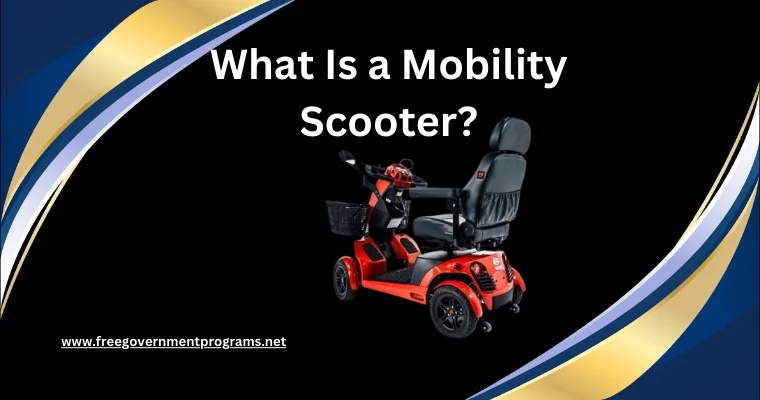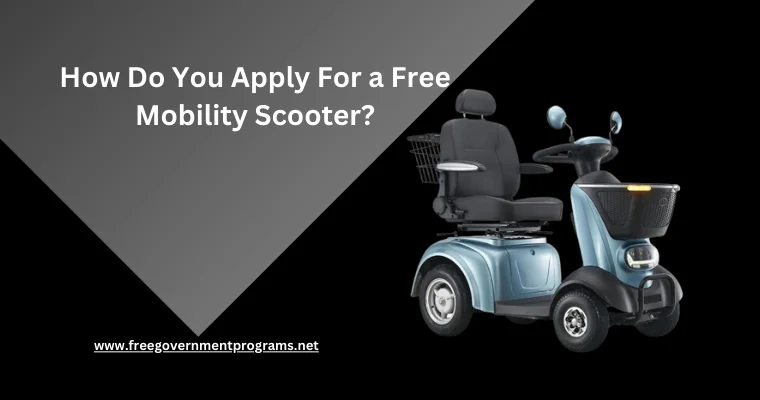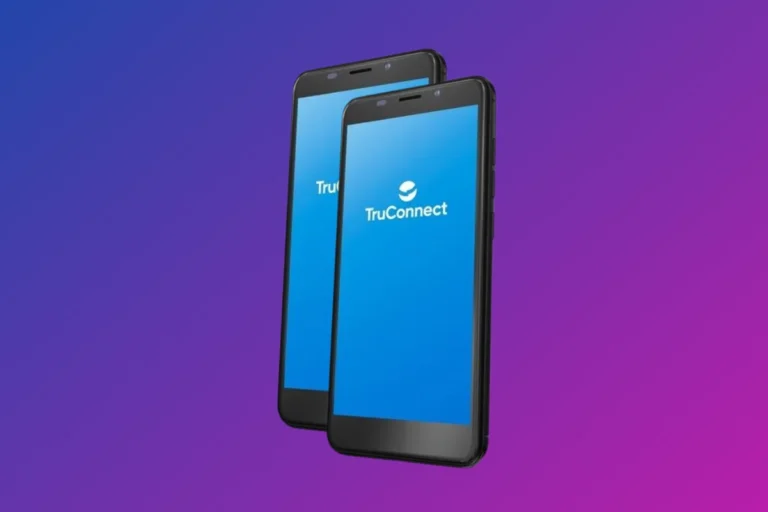Free Mobility Scooter – Are You Ready To Move With Ease?
Do you need a mobility scooter but can’t afford one? You’re not alone. Mobility scooters cost a lot, making it hard for many people with disabilities to buy or rent one. It can be tough giving up freedom, independence, and outdoor activities. Luckily, there are ways to get a free mobility scooter, no matter your financial situation. Medicare, charities, and other groups also help people with mobility issues. Claim your free mobility scooter now and and start your adventures.

Some programs pay for the whole cost of an electric mobility scooter, while others help a bit. At Mobility Deck, everyone who needs a mobility scooter should be able to get one. That’s why we made this guide. It explains various ways to get a free mobility scooter for yourself or someone you care about.
What Is a Mobility Scooter?
Mobility scooters are electric vehicles shaped like motorized scooters, similar to power wheelchairs. It usually has a seat that can turn and three, four, or more wheels. It runs on a battery; one charge can make it go for several miles. You can charge it with regular electricity. Furthermore, these scooters are made for seniors and people with disabilities who have trouble moving around and doing everyday things.
Mobility scooters also help by supporting them in their daily activities. They can do housework, work, visit family, or spend time outside easily. A mobility scooter lets seniors and people with disabilities live a good life with independence and less physical effort.
How Much Does a Mobility Scooter Cost?
When you’re considering getting a mobility scooter, one really important thing to consider is how much it costs. There are many different kinds of scooters out there, and their prices range from $600 to $4000. However, the price depends on the scooter’s features and how much weight it can carry. The construction and features make these scooters a bit pricey due to their durability. Some scooters can carry up to 500 pounds, while others, which are lighter, weigh as little as 170 pounds.
If you only need a scooter for one person and are worried about the weight and limitations of the lighter scooters, consider a mid-range scooter. In addition, a mid-range scooter is a good, reliable choice, usually costing between $1000 and $1200. It will also give you benefits like a front container and a comfortable seat. And don’t worry, if you’re interested in getting a free scooter, we’ll tell you more about that as you keep reading.
Ways To Get a Free Mobility Scooter:
Government programs and charities give free mobility scooters to seniors and people with disabilities. Getting a free scooter can improve their lives by allowing them to move around independently and do their daily activities. So, if you are one of those who want to get a free mobility scooter, here are some ways:
1. Medicare
Medicare has programs to help people with disabilities and seniors who need mobility scooters. One common program is Medicare Part B. Medicare Part B usually covers mobility equipment, but you must meet specific requirements. You must have medical conditions that limit your movement and make it hard to do daily activities like bathing or dressing. Additionally, a doctor approved by Medicare must say the mobility scooter is “medically necessary” and write a prescription.
Medicare Part B might pay up to 80% of the cost of a mobility scooter, but it’s not guaranteed. Basic scooters usually cost $600 to $2,000, so Medicare’s help could bring your cost down to about $120 to $400.If you have a Medicare supplemental policy (Medigap), it may cover the remaining 20%. Check your policy for details, as each one is different. For those who can’t afford the remaining 20%, Medicaid might help.
Medicaid programs vary from state to state, so contact your local Medicaid office for information on Medicare Savings Programs. Veterans have more options, too. The Department of Veterans Affairs has funding programs like TRICARE, CHAMPVA for Life, and Veterans Directed Home and Community-Based Services (VD-HCBS) that might cover the remaining 20%. But, like Medicaid, there are specific criteria and possibly a minimum active duty service time.
Understanding how Medicare covers mobility scooters helps you make informed choices about getting the mobility aid you need.
2.Medicaid
In Medicaid, the federal government and states work together to ensure health care for people with low incomes. It helps pay for medical costs for families with low incomes. This program gives free medical services to families with low income, and it also provides important medical equipment like mobility scooters. If you’re a low-income senior or have a disability, Medicaid can give you a free mobility scooter.
But, to get a free scooter, you need to meet certain requirements for low-income families. These requirements can be different in each state, so it’s best to contact your local Medicaid office to find out if you qualify for a free mobility scooter. Here are some general things to know about qualifying for a free mobility scooter from Medicaid:
- Your income and your family’s income should be below a certain level set by the government.
- You should be 65 years or older.
- You must have a permanent disability.
- Pregnant individuals can also qualify.
If you fit these criteria, Medicaid might be able to help you get a free mobility scooter.
3. Your Insurance Company
So, will your health insurance help pay for a mobility scooter? The good news is that it’s possible, but there are some things you need to do.
- First, check your insurance policy for details. Look closely at the “Durable Medical Equipment” (DME) section because mobility scooters often fall under this category. Not all insurance providers cover DME, so check with them before assuming anything.
- If the insurance terms confuse you, don’t worry. Just call your insurance company and talk to their customer support. Write down what they say; it might be useful later.
- Before you try to get the insurance to pay, you’ll need a ‘Certificate of Medical Necessity’ or a prescription from your doctor. This paper says, “Yes, you need this scooter for medical reasons.”
- Some insurers might make things trickier by requiring pre-authorization for DME. If that’s the case, don’t skip this step; do it.
- Collect all your documents, including the prescription and pre-authorization forms. Send them to your insurance company.
- Keep an eye on your claim, as you might need to provide more information.
- If all the paperwork seems too much, many mobility scooter companies can help. Even though they want to profit, some companies have special departments to assist with insurance claims and make things easier for you.
4. Grants and Charities:
If you need a free mobility scooter but can’t afford one, there are grants from community charities and foundations that can help. Some notable foundations include
- Numotion Foundation: They offer financial help for people who need mobility scooters and wheelchairs through their Grants and Sponsorship Program.
- ALS Association: They operate an Equipment Loan Closet program, which provides mobility scooters and other equipment for individuals who have ALS.
- Muscular Dystrophy Association: They assist individuals affected by muscular dystrophy get mobility scooters through their Equipment Assistance program.
- Multiple Sclerosis Foundation: At this foundation, you can get mobility aids, such as scooters and other aids, to improve your quality of life.
- United Spinal Association: They have a list of available grants for people with disabilities.
However, getting one of these grants is more than just a first-come, first-served situation. Each organization has its own eligibility criteria and application deadlines. It’s not only about applying quickly; you must also meet their requirements.
Additionally, the grants depend on available funds, so that timing can be important. Many charities keep waiting lists, giving you a chance when funds become available.
For the application process, you usually need an application form, proof of income, and evidence of your medical need for a mobility scooter. A letter from your doctor can often prove your medical need.
5. The American Outreach Foundation
Helps Veterans and those from lower-income families in Southern California’s Coachella Valley by providing free mobility chairs and scooters. If you want a free scooter or power chair from them, here’s what you need to do:
- Visit their website and complete the application form.
- To qualify, you’ll need:
- A doctor’s recommendation says you need a mobility scooter or power chair.
- A letter from your insurance company saying they won’t pay for it.
- Financial records, like your tax return or annual SSI income, show you need financial help.
Either a prescription or a letter of medical necessity from a healthcare professional. Keep in mind that only people living in Coachella Valley can apply. Keep going even if you meet all the requirements. Call them; they might guide you to another organization that can assist you.
For more information about the American Outreach Foundation, their programs, and how to get the application form, visit their website at www.americanoutreachfoundation.com.
6. Latter-Day Saint Charities
Latter-day Saint Charities are known for helping people in Africa, Asia, and Europe, but they also assist Americans. This Christian charity, supported by the Church of Jesus Christ of Latter-day Saints, doesn’t just focus on global aid; it helps people right here in the United States.
One impressive program they have provides free wheelchairs and other mobility aids, including scooters. The money comes from church members and friends who want to help those in need.
To see if you qualify, you must understand that the program is different for everyone. The program is designed to match individual mobility aid needs with appropriate mobility aids. Your eligibility might depend on a few things, like your specific medical need for a mobility aid, evidence that you’re facing financial difficulties, and even where you live.
For more details, visit their official website latterdaysaintcharities. There, you can find all the information on how to qualify. If a free mobility scooter or chair could make a big difference in your life, take the time to learn about their requirements. This way, you’ll be ready to apply and take the next steps.
7. Social Security and State Disability Assistance
State disability benefits and Social Security Disability Insurance (SSDI) might help cover the cost of a much-needed mobility scooter, either fully or partially. These are also government programs that aim to assist individuals with disabilities.
To qualify, you usually need to meet specific medical criteria and, for SSDI, have worked for a certain number of years, accumulating enough work credits.
The application process involves submitting medical records, proof of income, and sometimes undergoing medical examinations. It’s also a good idea to consult with a social worker or legal advisor who knows about disability claims to help you through the process.
One challenge is the varying waiting periods for your application to be processed. SSDI claims can take up to six months for initial review, and state disability benefits waiting times can differ.
If your application is initially denied, you can appeal, but it will prolong the waiting period.
8. Supplemental Security Income (SSI)
People with limited resources and income may qualify for Supplemental Security Income (SSI) to cover the cost of mobility scooters. For temporary solutions, you can rent scooters at a subsidized rate or use public transportation while waiting for approval.
However, if you’ve tried other options without success, don’t lose hope. Social Security and State Disability Assistance are still viable options, but be aware of the paperwork and the waiting period. Making sure you meet all eligibility criteria and being patient will increase your chances of getting the approval you need.
Criteria and Steps to Obtain a Mobility Scooter
Getting a mobility scooter is easy. Still, it’s important to know that each program that helps with money has certain rules and limits.
For example, you usually need a prescription from your doctor to get a scooter. This prescription should have details like the following:
- Why do you need the mobility scooter?
- What type of scooter is best for your situation?
- How long do you need it?
- Financial Proof: You often have to show proof of your income, like tax returns or pay stubs, to check if you qualify for financial help.
- Medical Records: Many programs require you to submit a full medical history or specific medical tests.
- Prior Approvals or Denials: Prior approvals or denials might help you apply for other programs if you have a record of them.
- Application Forms: Most organizations ask you to fill out a form. Some even have an online form, which can make things quicker.
- Waiting Period: Be ready to wait. It can take a few weeks to several months, depending on the organization and how many people need scooters.
- Follow-ups: Check on your application. Some organizations give you a case number or a person to contact to see how things are going.
- Resources in your local community: Some community centers and disability services can assist you in locating mobility scooters in your area. Pay attention to these local resources.
Your first step toward a free mobility scooter is to contact the organizations listed here. Obtain the necessary documents and advice from your doctor or physical therapist. It doesn’t guarantee you’ll get a free scooter, but it increases your chances of getting it for free.
How Do You Apply For a Free Mobility Scooter?
Getting a free scooter is simple, but before you apply, you should check if you meet the requirements of the government program or organization you’ve chosen.

Here’s What You Need To Do:
Visit a medical specialist and have some tests done to see if you qualify for a free mobility scooter.
Once the doctor says you qualify, they’ll give you a special prescription for the free scooter.
Contact the charity you picked with this prescription to apply.
However, if they have a mobility scooter available, they’ll give it to you right away or help with the cost if needed.
Benefit Of Mobility Scooters For Seniors and The Disabled
Using a mobility scooter is easy to understand, but some might find it unclear. Mobility scooters can also be really helpful for seniors and people with disabilities in a few ways:
- Sense of Independence:
If you have a mobility scooter, you can move around on your own without always needing help, especially when you go outside.
- Speed of Travel:
Unlike wheelchairs that need someone to push them, mobility scooters let you move quickly by yourself.
- Safe Way to Travel:
A mobility scooter can make you feel safer, especially if you’re older or not very steady on your feet.
- Taking a Park Walk:
If the paths are good for wheelchairs, using a mobility scooter means you can join friends or family for a walk in the park. Being outside is good for your body and mind.
- Essential Items to Pick Up:
You should go to a pharmacy for a prescription or to a nearby shop for things you need. A mobility scooter makes this easier.
- Improved Lifestyle:
Mobility scooters let seniors and people with disabilities move around by themselves, giving them more time outdoors. Spending time outside can also boost their health and happiness.
Conclusion
Securing a free mobility scooter is vital for individuals who need assistance but face financial constraints. Mobility scooters, designed for seniors and those with disabilities, offer independence and aid in daily activities. With costs ranging from $600 to $4,000, affordability becomes a significant hurdle, impacting individuals’ autonomy and outdoor engagement. This guide presents more than seven avenues for obtaining a mobility scooter.
However, understanding the criteria and steps for securing a free mobility scooter, combined with proactive outreach to relevant organizations, enhances the likelihood of approval. While paperwork and waiting periods are inevitable, persistence ensures the much-needed mobility aid becomes accessible.
Frequently Asked Questions:
Q: How Can I Get a Free Mobility Scooter?
Ans: You can get a free mobility scooter from places like Medicare, Medicaid, and different charities. These are groups that help people who have trouble moving around, especially seniors and those with disabilities.
Q: Can I Get a Free Mobility Scooter on PIP?
Ans: You can receive a free mobility scooter through PIP. If you’ve been given the Enhanced Rate PIP Mobility Component and have at least one more year left on the award, you qualify for the free scooter under the Mobility Assistance Program.
Q: Can I Get a Grant for a Mobility Scooter?
Ans: Absolutely! You can receive financial help for free mobility scooters from various nonprofit organizations and charities. One example is the NewMotion Foundation, which offers financial assistance through its grants and sponsorship program for wheelchairs and scooters, specifically for those facing mobility challenges. You can also obtain free wheelchairs and mobility scooters through the following charities:
- United Way
- Wheelchair Foundation
- United Spinal Association
- Lions Club
- Vantage Mobility International
- Easterseals
- Triumph Foundation
- Multiple Sclerosis Foundation
- Joni and Friends
- Tyler Schrenk Foundation
- Hope Heaven
Moreover, these organizations aim to support individuals in need, so you can explore these options for assistance in getting a free mobility scooter.
Q: Do Mobility Scooters Require Insurance?
Ans: No, buying insurance for mobility scooters is not obligatory. However, if you are obtaining a mobility scooter via a health insurance provider, they might suggest or even insist on purchasing insurance.
Q: Can I Rent a Mobility Scooter?
Ans: Yes, you have the option to lease a mobility scooter. Those who are unable to receive financial aid for a free scooter or are faced with an extended waiting period might discover that renting a scooter is a more cost-effective solution, especially when the device is needed for a short duration.





